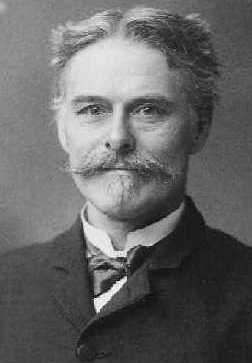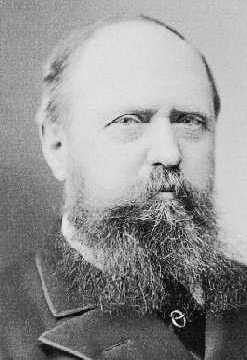
The Cope -Marsh Feud:
The New York Herald,
January 19 and 20, 1890
Copyright © 2002-2008 by Mike Everhart
Page created 06/04/2002; updated 02/24/2008

 |
The Cope -Marsh Feud: The New York Herald, January 19 and 20, 1890 Copyright © 2002-2008 by Mike Everhart Page created 06/04/2002; updated 02/24/2008 |
 |
On Sunday, January 19, 1890, the following letter appeared on page 11 of the New York Herald as part of a series of stories written by William H. Ballou on the Cope-Marsh rivalry. In it, O. C. Marsh recounts, with perfect 20/20 hindsight, the events surrounding the saga of the "head on the wrong end" Elasmosaurus of Professor E. D. Cope twenty years earlier. Strangely, Marsh did not publish his "discovery" of the error in 1870 when it would have been most damaging to Cope, but instead waited 20 years to claim the moral "high ground" in a newspaper story that was little more than "muck-raking". In his reply the following day, Cope said, in effect, "I made a mistake. I corrected it. It's ancient history. Get over it."
WRONG END FOREMOST "Professor Cope had described an extinct reptile from the cretaceous of Kansas, under the name Elasmosaurus, and his published descriptions made this the most remarkable animal of ancient or modern times. Besides his original description, he had read a paper on the subject before the American Association in which he explained the marvelous creature. In a communication published by the Boston Society of Natural History in 1869 he placed it in a new order, Streptosauria. In the American Naturalist, he gave a restoration of the animal, represented as alive. This was afterward copied in "Appleton's Cyclopedia." Finally, an extensive description was published in the "Transactions of the American Philosophical Society," Vol. XIV., in which a full restoration of this wonderful creation was given. The skeleton itself was arranged in the Museum of the Philadelphia Academy of Sciences, according to this restoration, and when Professor Cope showed it to me and explained its peculiarities, I noticed that the articulations of the vertebrae were reversed and suggested to him gently that he had the whole thing wrong end foremost. His indignation was great, and he asserted in strong language that he had studied the animal for many months and ought to at least know one end from the other. It seems he did not, for Professor Leidy in his quiet way took the last vertebrae of the tail, as Cope had placed it, and found it to be the atlas and axis with the occipital condyle of the skull in position. This single observation of America's most distinguished anatomist, whom Cope has wronged grievously in name and fame, was a demonstration that could not be questioned, and when I informed Professor Cope of it his wounded vanity received a shock from which it has never recovered, and he has since been my bitter enemy. Professor Cope had actually placed the head on the end of the tail in all his restorations, but now his new order was not only extinct, but extinguished. |
His first act was eminently characteristic of
him. He at once endeavored to recall the part of the transactions of the
American Philosophical Society in which his erroneous description and restoration were
published, but he did not succeed. He thereupon issued the following printed
circular, dated Philadelphia, March 25, 1870, a few days after I had informed him of his
error and Professor Leidy's demonstration of it: Professor Cope's Circular An error having been detected in the letter press of the "Synopsis of the Extinct Batrachia and Reptilia of North America," by Edward D. Cope, it will be necessary to cancel and replace one of the forms. The author therefore requests that the recipient of this notice would please return his copy of said work to the author's address, at his expense. The volume will be returned, postpaid, with Part II, of the same work, which will be sent to those who have received the corrected Part I. Later he issued a second edition of the volume, containing a new restoration, with the head in it's proper position, but there was nothing to show that a previous edition of the work had been published. Of the first edition, numerous copies are extant. I returned to Professor Cope at his request the one he sent me, but have two others which I since purchased. There is one copy in the British Museum, several in Philadelphia and doubtless many others in this country and Europe, and their existence cannot be ignored, much as Professor Cope desires it. I give this transaction as one sample of Professor Cope and his methods -- one taste of the cheese."
|
Cope's brief reply to Marsh was published in the New York Herald the following day (Monday, January 20, 1890):
"PECCAVI" TO THE LIZARD STORY "To the charge of turning a lizard without a head wrong end about I answer "peccavi" [Latin - I have sinned] to some extent. But I wonder at Marsh to repeat this ancient story, since it compels me to bring into prominence another scientist, my predecessor in the same field, who had done exactly the same thing and worse. I was able to correct part of the error of this author, but did not reverse the animal as I should have done. In a very short time, my predecessor saw the error he and I had committed and corrected it in print without previously informing me." [Cope is referring here to Professor Leidy's earlier (1851) mis-identification of vertebrae from a fragmentary plesiosaur (Cimoliasaurus) specimen. When he saw Cope's restoration of Elasmosaurus in 1869-70, Leidy realized his own mistake and admitted that he had also been wrong. In that sense, the discovery of Cope's error made it possible for Leidy to improve the knowledge of the time regarding plesiosaurs.] |
For additional information on this subject, see my ePapers on the Web, and my marine reptile references.
Credits: A big "Thank you!" to Earl Manning for his 2002 invention of the term, "ePaper", his editorial assistance and his contribution of many 1800s paleontology papers, including a copy of this story from the New York Herald. This page would not have been possible without his help.